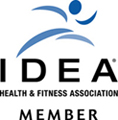I was training a client last week who informed me she was headed on vacation. When I told her to make sure she "ate really clean" to make up for any missed workouts, she nodded but looked confused. When we later discussed "cleaning up the diet" to speed up her desired weight loss, she finally broke down and asked me:
"What exactly do you mean by 'cleaning it up'?"
Trainers tend to throw around terms (think "engage the core" or "breathe into the contraction") that aren't necessarily clear at first glance - and it is well within the rights of the client to ask for further clarification. Any trainer worth her salt will be able to explain anything related to their programming - what muscle is being used, why you're doing a certain exercise in a certain order, how many calories are being burned during a given activity - so feel free to ask, always.
But I digress. The real purpose of this post is to explain what "clean eating" means and why it is a central component of weight loss. The best-regarded Clean Eating Queen is none other than Tosca Reno, a supermom, fitness model, and lifestyle guru responsible for a full line of best-selling Eat Clean books. While simple in concept, eating clean does demand a few notable changes in your regular eating habits - which, once achieved, are remarkably easy to maintain.
First, avoid almost all processed foods. This means that if the food does not arrive to you in its natural form (i.e., a potato in its skin pulled from the ground; a head of fresh broccoli without cheese or salt; a whole grain shucked from its chaff and unrefined), it is likely a "processed" food, which means a person or machine has changed the nutritional profile of the food. Avoiding these foods is the easiest way to avoid added sugars, sodium, and saturated and trans fats. There is, however, one notable exception...
Eat lowfat dairy in moderation. 2-3 small servings of nonfat dairy (think skim milk, lowfat cottage cheese, or part-skim "light" string cheese) can actually burn fat and help speed up weight loss. If you aren't a big fan of dairy, try blending your cottage cheese into a fruit smoothie to add creaminess or enjoying milk with your steel-cut oats in the morning - both are ways to integrate dairy without consuming too much.
Third, make sure the bulk of your meal is comprised of low-starch vegetables, lower-sugar fruits, and lean protein. These are the cornerstones of clean eating and can be eaten, within reason, without limitations (especially leafy greens!). When you look at your dinner plate, use your hand to estimate portions - it should have a palm-sized protein (skinless chicken is nutritionally the best), a fist-sized fruit (I like mine as dessert!), a two-hands-open serving of veggies, and about three fingers' worth of unrefined whole grains (like bulgur, barley, oats, quinoa, or spelt). If you are thinking to yourself that clean eating really keeps you full, you're right - there are a large variety of foods to choose from and you'll rarely, if ever, get bored.
Finally, abstain from caloric drinks, including soda (also a processed food), alcohol (carb-central), and sugar-bloated coffee drinks (black coffee and tea are always OK!). Clean eating centers on just that - eating!- so drinking your calories away is a surefire way to keep yourself starving, lethargic, and grouchy.
If you have trouble figuring out which foods are "clean" and which are to be avoided while on your weight loss journey, why not try a nutrition consultation with bene-fit? We offer comprehensive evaluations of your current dietary habits, a nutritional assessment of your pantry, and realistic food recommendations for you and your family.
Remember, in the weight loss battle, only 20% of the fight is won in the gym. The other 80% depends on what you put in your mouth - and with clean eating, the choices are clear. Stick to real foods, avoid the junk, and hydrate with fresh, cold water. You'll start feeling the differences in no time!
August 29, 2011
Subscribe to:
Comments (Atom)



